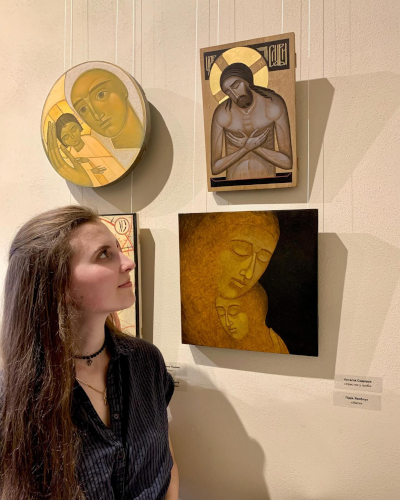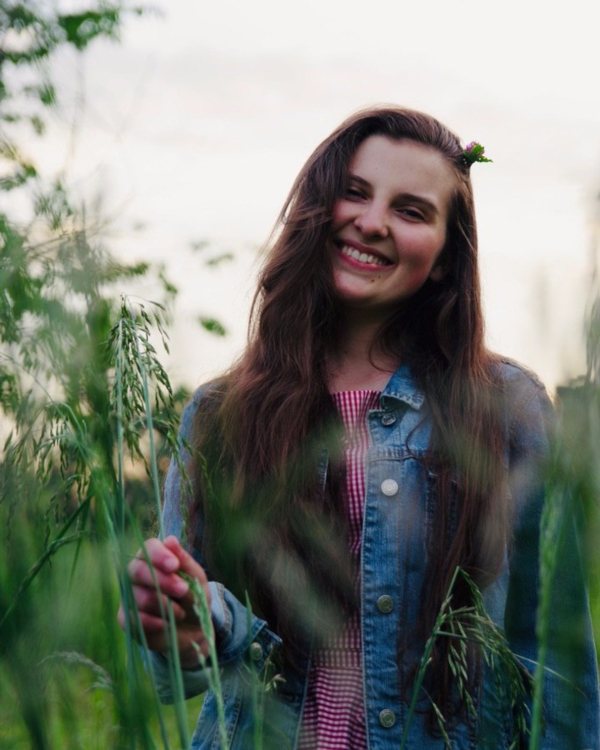Natalia Sydoruk
I often find solace in reinterpreting ancient biblical stories and investing them with new meanings that are relevant to the present-day. In this way, my work undergoes change and becomes a mirror of my inner journey. "
Natalia Sydoruk
My name is Natalia Sydoruk and I am from Lviv, Ukraine.
I was born on September 5, 1997 in a small town called Manevychi in the Volyn region, surrounded by coniferous forests.
In junior high school, around 2005, I met my art teacher Oksana Melnyk. After school, I attended art lessons in her studio and loved spending time there. Drawing became my favorite hobby. We usually had a tea break with all of Oksana's students, sometimes playing board games and making small trips to surrounding towns. I found friends and a great community there.
Oksana introduced me to practical Christianity: she sang in the church choir, and in the studio we often listened to audio recordings for children about Christian saints. When I was thirteen years old, religion, and Orthodoxy in particular, provided answers to many teenage existential questions.
Soon, I began to actively attend church services, and tried to learn more about the history and culture of Orthodox Christianity. Church singing and the Eucharist became the main parts of my devotional life. The visual art of the church fascinated me with its artistic beauty and mysterious symbols.
This was the beginning of my journey of learning about the icon as a work of art and a relic that witnesses different epochs of Ukrainian history.
Not only did we study classical Byzantine iconography of the Paleolithic period; we also learned about the theology of the icon. Through examining museum collections, we were introduced to Western Ukrainian iconography from the thirteenth century onwards. Alongside this historic art, we encountered monumental painting of the twentieth century, which transformed and reinterpreted traditional iconography through drawing inspiration from mainstream artistic processes and styles.
Our main task was to learn how to understand the composition, painting, and symbolism of an icon and to use these elements to create our own iconographic stories. This approach enabled us to transform the traditions and practices of traditional iconography into the language of our work, so that the icon's symbolism does not become an obstacle for modern audiences and viewers.
As a Master's student at the Lviv National Academy of Arts, I studied ancient iconographic techniques alongside the latest materials. While I chose traditional iconography for my graduation projects, I added acrylic painting techniques and used modern materials. I took part in collective exhibitions, including for the twentieth anniversary of the Department of Sacred Art at the Pinzel Museum ((English via Google Translate in Lviv (2015). My 2018 thesis project was an icon of Christ enthroned for the altar of a monastery in Volyn. The following year, I took part in an icon plein painting exhibit in Nowica, Poland. This project toured Europe. My final master's project in 2020 was an icon of the enthroned Virgin Mary with Saints Yuri and Barbara. Today, it is housed in the New Athos Monastery in Lviv. After graduating, I participated in the plein air "Resurrection and Ukraine" exhibition in New Jersey in 2024.
For some time after graduating from the academy, I painted icons for my Christian friends from church, largely focussing on small, personalised pieces. Although my Christian friends were more accustomed to traditional icon painting, they accepted my style of icon painting and supported my quest.
However, I wanted to develop more creative works and started working with the Iconart Gallery in Lviv. Here I found a space to show my art and have since participated in collective Christmas and Easter exhibitions.

Later, while teaching at a children's art school, I held my first icon painting workshop. I realised that, in addition to painting, I wanted to share my knowledge of the icon. It was the beginning of a new era of delving into classical medieval techniques, the history of iconography, and the local history of Ukrainian medieval church painting.
In February 2024, my colleague Viktoria Skubko and I organized icon painting classes in Lviv for students aged twelve and above. These classes have been running for eight months, once a week, on Thursday evenings. After work and school, adults and teenagers have the opportunity to detach themselves from the realities of the war and plunge into the world of ancient Ukrainian icons for two hours.
In addition to teaching, I am currently painting an icon of all the Ukrainian saints for a church. This image depicts forty local Ukrainian saints, and seven national churches and monasteries that represent God's divine protection for the Ukrainian people at this tumultuous time.
Iconography and icon painting have become an integral part of my life. Russia's war against Ukraine has impacted the themes of my work. I often find solace in reinterpreting ancient biblical stories and investing them with new meanings that are relevant to the present-day.
In this way, my work undergoes change and becomes a mirror of my inner journey.


